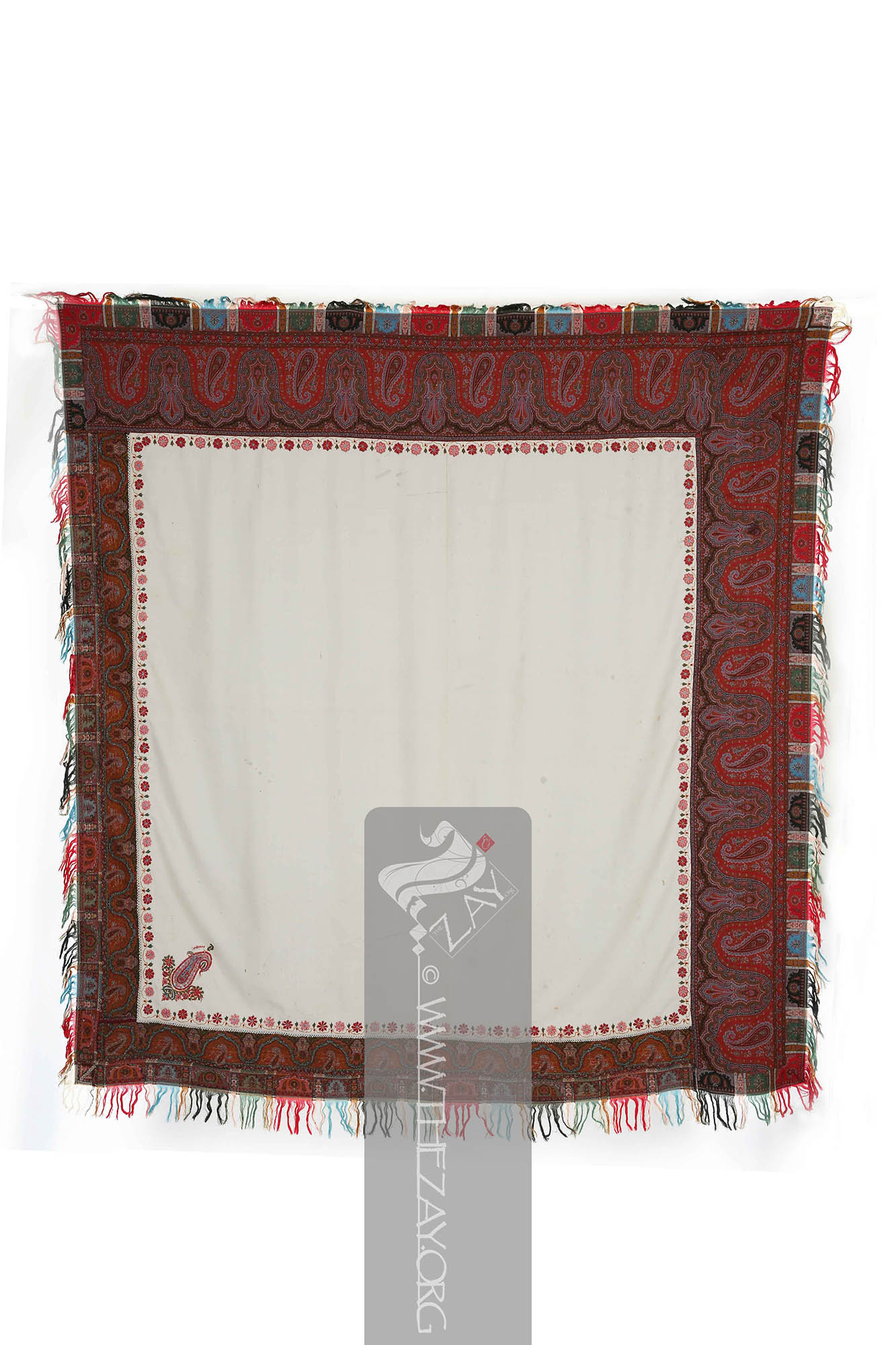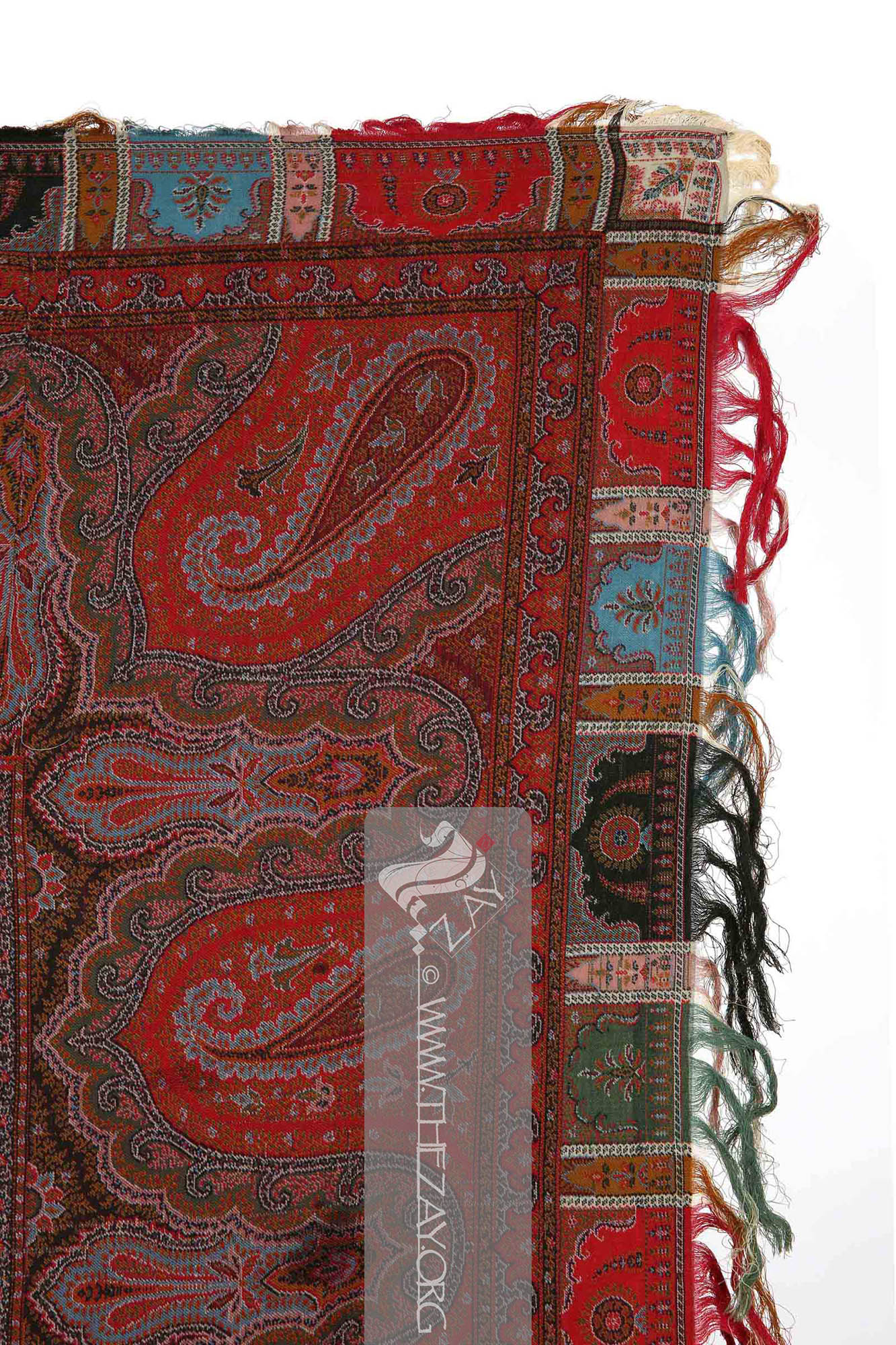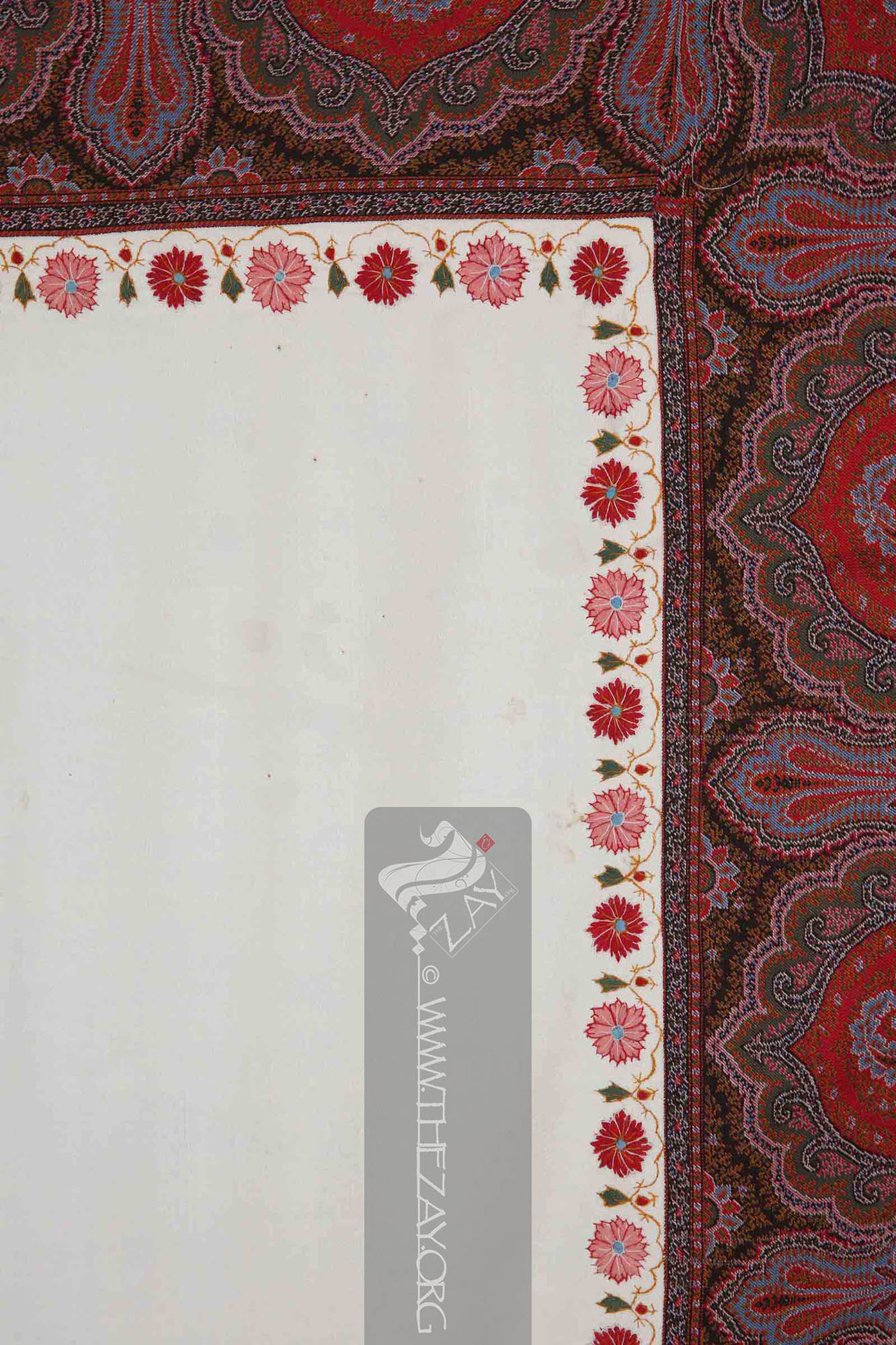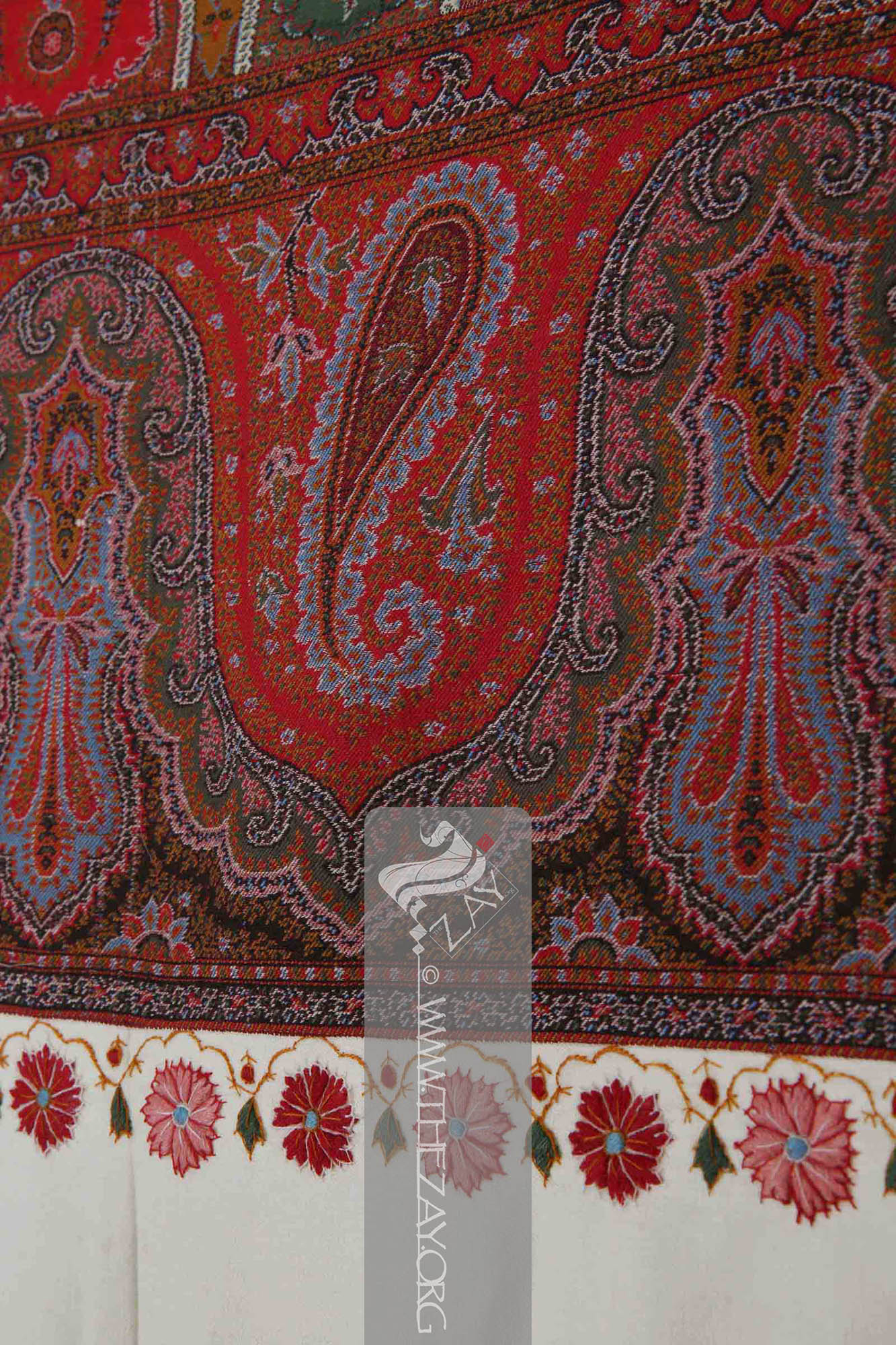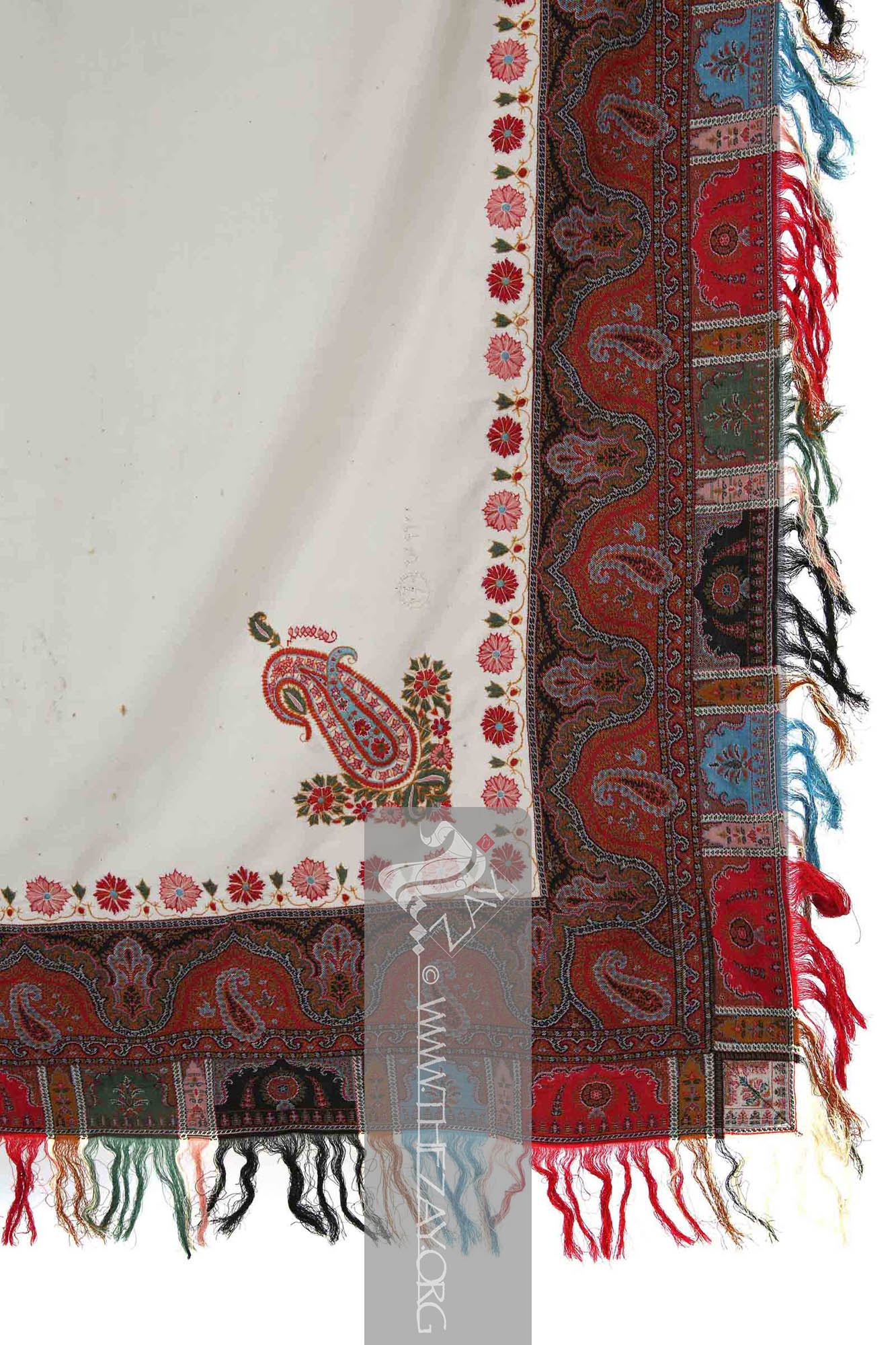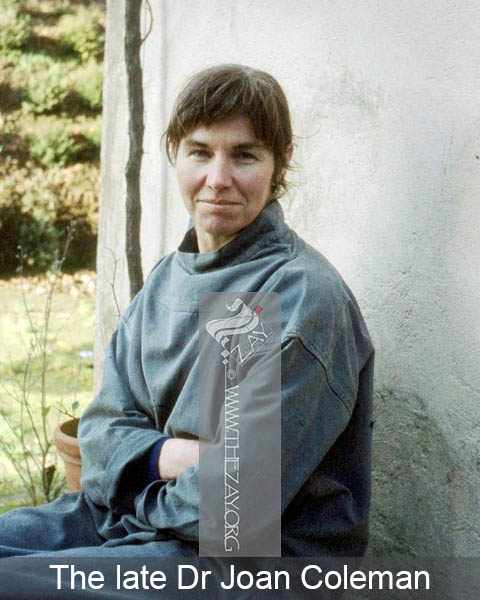Object NotePart of a set of a trio comprising (
ZI2020.500778 EUROPE) and (
ZI2020.500780 EUROPE).
Object HistoryThis colourful (
shawl
Shawl: (Persian: shāl from Hindi: duśālā – Shoulder Mantle), a shawl is a South Asian version of a scarf worn or wrapped loosely over the shoulders and is usually made of wool. ) dating back to the mid-19th century was originally part of a trio along with (
ZI2020.500778 EUROPE) and (
ZI2020.500780 EUROPE) at the Dr Joan Coleman Collection. It was first purchased at an auction at Phillip’s in June 1999. Later The
Zay
Zay: (Arabic: costume, Pl. azyaā’), a set of clothes in a style typical of a particular country or historical period. Initiative managed to acquire it from Kerry Taylor Auctions in 2020.
Dr Joan Coleman began collecting shawls in 1976 and developed her lifelong passion for collecting. She was a regular at the London salesrooms of Christie’s, Sotheby’s, and Phillips – three of the most outstanding auction houses of the period in the world – getting to know the dealers and learning in the process. She acquired vast knowledge and dedicated hours carefully cataloguing her ever-growing collection. She intended to loan her collection to different museums and institutions for the benefit of learning and education. Her collection is one of the largest and the finest private
shawl
Shawl: (Persian: shāl from Hindi: duśālā – Shoulder Mantle), a shawl is a South Asian version of a scarf worn or wrapped loosely over the shoulders and is usually made of wool. collections to have ever graced the world with shawls ranging from Kashmir,
Paisley
Paisley: (Scottish Gaelic, Pàislig: a town in Scotland), often called buta, boteh, amli, or kalgi in the subcontinent and kazuwah in Arabic, is a Persian tear drop motif with a curved end specially in textiles. Its popularity and subsequent local production in 18th century at Paisley are responsible for its nomenclature., Edinburgh, Norwich, France, and Iran.
Object Features This rectangular
shawl
Shawl: (Persian: shāl from Hindi: duśālā – Shoulder Mantle), a shawl is a South Asian version of a scarf worn or wrapped loosely over the shoulders and is usually made of wool. is woven in an ivory base and embellished with vibrantly colourful wool. Dating back to c.1850-60 this piece is a unique example of its time because although it is rectangular, there is not much difference between the length and width making it look almost square. It is neither a square
shawl
Shawl: (Persian: shāl from Hindi: duśālā – Shoulder Mantle), a shawl is a South Asian version of a scarf worn or wrapped loosely over the shoulders and is usually made of wool. nor a full-length rectangular
shawl
Shawl: (Persian: shāl from Hindi: duśālā – Shoulder Mantle), a shawl is a South Asian version of a scarf worn or wrapped loosely over the shoulders and is usually made of wool. . In fact, the asymmetric design distribution with all four borders of four different widths further enhances its singularity.
The body of the
shawl
Shawl: (Persian: shāl from Hindi: duśālā – Shoulder Mantle), a shawl is a South Asian version of a scarf worn or wrapped loosely over the shoulders and is usually made of wool. comprises of a plain ivory field that is embellished with hand-embroidered pink and (
crimson
Crimson: (Persian/Arabic and Turkish: qirmiz or kirmiz – red), is a vivid red color originally made from the dried bodies of a scale insect of the Kermes genus native to the Mediterranean region and was used as a dye for clothing and textiles.) red flowers placed alternately and separated by a green foliate motif. This entire arrangement sits on a thin central vine that runs around the four sides in yellow. A tilted stylized (
paisley
Paisley: (Scottish Gaelic, Pàislig: a town in Scotland), often called buta, boteh, amli, or kalgi in the subcontinent and kazuwah in Arabic, is a Persian tear drop motif with a curved end specially in textiles. Its popularity and subsequent local production in 18th century at Paisley are responsible for its nomenclature.)/(
kunjbuta
Kunjbuta: (Sanskrit: kunj – place or corner associated with greenery; and Sanskrit: buta – foliage motif), the word is probably a portmanteau of two Sanskrit words it usually refers to the corner ornaments or decoration on a shawl
Shawl: (Persian: shāl from Hindi: duśālā – Shoulder Mantle), a shawl is a South Asian version of a scarf worn or wrapped loosely over the shoulders and is usually made of wool. . ) with a blue (
shikam
Shikam: (Persian: shikam or shikm – Belly or stomach), the belly of a buta or a paisley motif. ) placed on a base of mostly
crimson
Crimson: (Persian/Arabic and Turkish: qirmiz or kirmiz – red), is a vivid red color originally made from the dried bodies of a scale insect of the Kermes genus native to the Mediterranean region and was used as a dye for clothing and textiles. and pink flowers and green foliage adorns one corner of the white field. A faux signature in Arabic script or perhaps an imitation of it in ivory (
resham
Rīsham: (Persian: abrīšam – silk yarn), referring to silk threads in the Indian subcontinent and Iran. )/ silk (
floss
Floss: (Old French: flosche – nap of velvet), is a type of silk fibre obtained from the cocoons of wild silkworms. It is characterized by its long, fluffy fibers that are not tightly woven, making it ideal for use in various textile applications such as embroidery, lace-making, and sewing.) thread is placed subtly next to the
kunjbuta
Kunjbuta: (Sanskrit: kunj – place or corner associated with greenery; and Sanskrit: buta – foliage motif), the word is probably a portmanteau of two Sanskrit words it usually refers to the corner ornaments or decoration on a shawl
Shawl: (Persian: shāl from Hindi: duśālā – Shoulder Mantle), a shawl is a South Asian version of a scarf worn or wrapped loosely over the shoulders and is usually made of wool. . .
The piece has two sets of borders both stitched to one another and subsequently to the ivory piece on the machine. The inner border runs in four different sizes on four sides and comprises of intricately woven paisleys and other floral motifs in (
vermillion
Vermillion: (Old French: vermeillon from Latin: vermiculus – worm), is a bright and vivid red hue that is often synonymous to red orange. It has been acquired from powdered cinnabar which is a form of mercury sulphide – a toxic chemical compound – since antiquity until the 19th century.) red, scarlet, yellow (
ochre
Ochre: (Greek: ōkhra – Yellow Ochre), is a natural earth pigment that ranges in colour from yellow to red-brown, often used in art and decoration. ), black and ivory. The outer border also woven in wool comprises (
turquoise
Turquoise: (French: turquois – present day Türkiye; Synonyms: firuze, pheroza), is a naturally occurring opaque mineral mined in abundance in Khorasan province of Iran and has been used for making dye for centuries. The term is a derivative of the French word for the country Türkiye once called Turkey. )/(
pheroza
: (Persian: pērōzah – "victory", later Arabic: fayrūz; Synonyms: firuze, turquoise
Turquoise: (French: turquois – present day Türkiye; Synonyms: firuze, pheroza), is a naturally occurring opaque mineral mined in abundance in Khorasan province of Iran and has been used for making dye for centuries. The term is a derivative of the French word for the country Türkiye once called Turkey. ), is a naturally occurring opaque mineral mined in abundance in Khorasan province of Iran and has been used for making dye for centuries. ),
vermillion
Vermillion: (Old French: vermeillon from Latin: vermiculus – worm), is a bright and vivid red hue that is often synonymous to red orange. It has been acquired from powdered cinnabar which is a form of mercury sulphide – a toxic chemical compound – since antiquity until the 19th century., moss and bottle green,
ochre
Ochre: (Greek: ōkhra – Yellow Ochre), is a natural earth pigment that ranges in colour from yellow to red-brown, often used in art and decoration. , pink, and black panels with floral bouquets under stylized arches. This gives way to tasselled fringes created by the threads of the same fabric in their corresponding colours hanging loose.
It is important to note that it is a (
turnover_shawl
Turnover_shawl: Traditionally made of fine silk and/or wool it was embellished on both sides at one corner or all over so that it could be folded diagonally into triangle for additional warmth and draped over the shoulders. Originally used in the Indian subcontinent it was made popular by Victorian women. ) as the embellishment at one corner is done on the underside so that it will be exhibited when folded and draped across the shoulders it.




